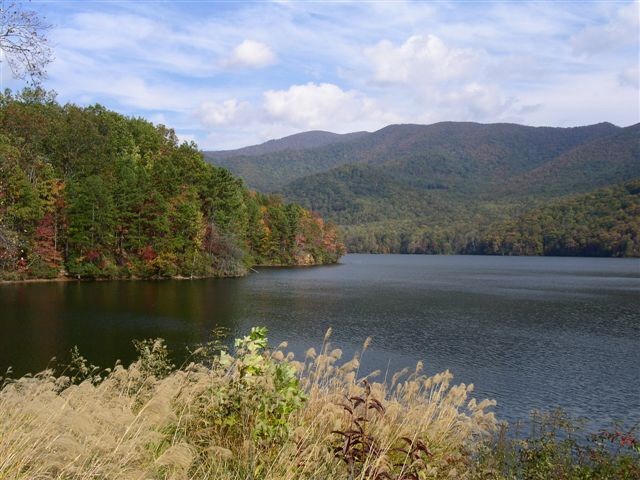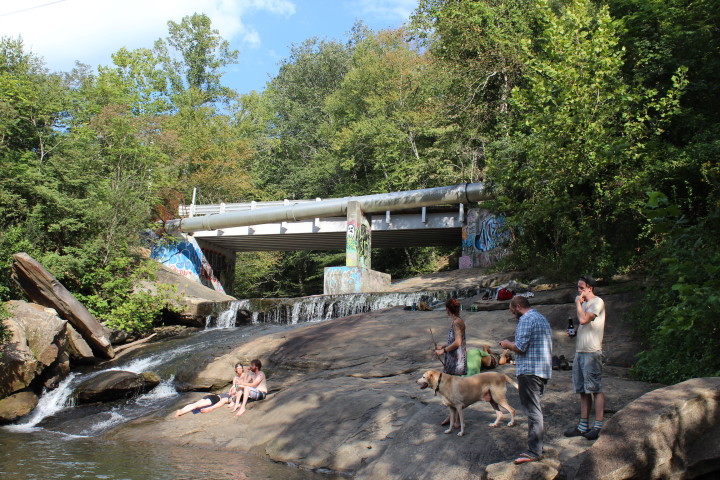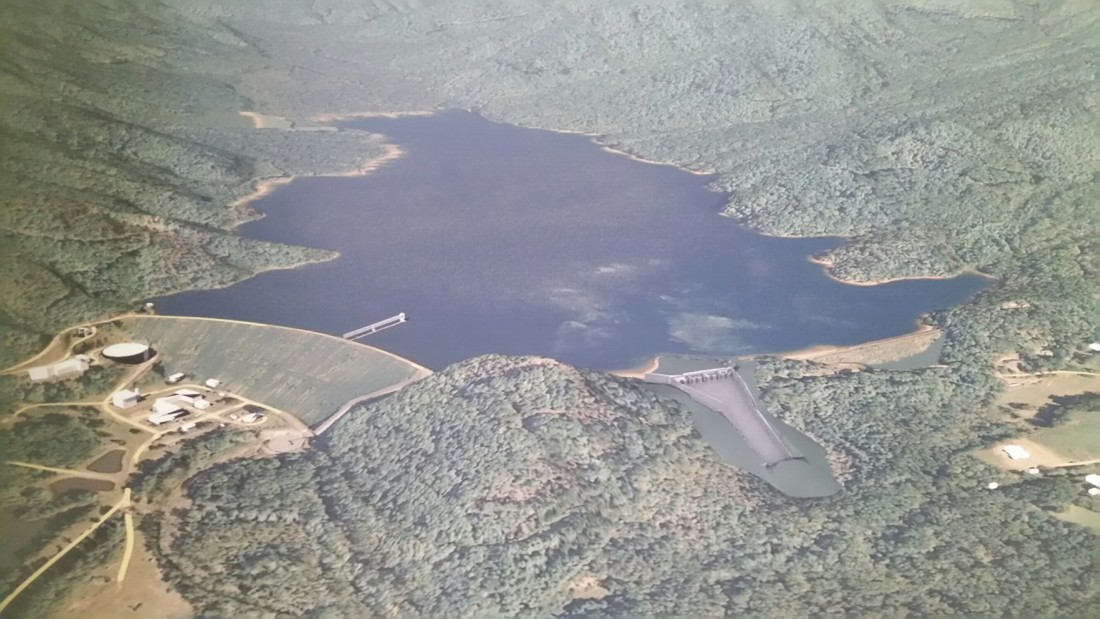Much of the responsibility for the safety of those who live and work below the Bee Tree and North Fork Reservoir dams rests on the shoulders of Swannanoa Fire Chief Anthony Penland. Ever watchful for the possibility of flooding, he and his staff keep one eye on long-range weather forecasts even as they train for and manage other emergencies.
At a public meeting on the evening of Aug. 25, as the setting sun tinted the sky over the Swannanoa Valley in shades of rose and gold, the chief spoke of a forecast of heavy rainstorms that could affect the area in a week’s time.
While flooding in low-lying areas is a constant concern, the chief’s nightmare scenario is a dam breech. “If a dam fails, get to high ground,” Penland advised Swannanoa residents who attended the public meeting to discuss planned improvements to the North Fork Reservoir dam. “There will be a wall of water 28 feet high coming at [emergency responders],” he said. “We won’t get there in time.”
Avoiding that scenario is one of the goals of a $30 million to $35 million plan to update the North Fork Reservoir’s dam to current state standards, Leslie Carreiro told residents who attended any of four information sessions held Aug. 22-25. Asheville’s Water Resources Department manages the North Fork dam under a flood operations plan developed in collaboration with the North Carolina Department of Environmental Quality Dam Safety Division, but the time has come to bring the dam up to current standards, explained Carreiro, a division manager in Asheville’s water department for the past 11 years. The Bee Tree dam, she says, was upgraded in the early 2000s.
Designed by Greensboro-based Schnabel Engineering in partnership with Asheville’s McGill Associates, the improvement project will add 4 feet to the height of the dam, update electronic instrumentation and monitoring systems, protect against earthquake damage, replace aging release gates at the main spillway and add a new auxiliary spillway designed to safely handle a 50,000-year rain event. A new bridge along the top of the dam will allow vehicle access from one side of the reservoir to the other, even if the road below the dam washes out due to flooding.
Latest in 1950s technology
When the North Fork Reservoir opened in 1955, it represented the latest in dam technology, Carreiro told citizens at the information sessions. But technology has changed over the last 60 years, and the state’s goal is to bring every high-hazard dam — that is, every dam whose failure could cause the loss of human life or significant property damage — up to current standards. The North Fork dam, Schnabel engineer Mark Landis said, falls short in a number of categories and requires significant improvements to meet regulatory requirements.
Today, the North Fork dam stands 130 feet tall and 1,200 feet long. Constructed from earthen fill excavated on the site, the dam creates a reservoir that provides 70 percent of the water in Asheville’s system. The city owns 22,000 acres surrounding and comprising the reservoir, which is the catch basin for a 20-square-mile watershed extending up the slopes of the Black Mountains.

A 36-inch pipe carries untreated water from an intake tower in the reservoir to a water treatment plant below the dam. From there, treated water is piped to Asheville water system customers.
In addition to the main dam, a 55-foot-tall, 600-foot-long “saddle” dam fills in a low spot in the topography at the mouth of the valley. The saddle dam is also an earthen structure.
Judgment call
Under the current flood operation plan, the water level in the reservoir is managed by water department employees in coordination with weather services and state regulators. When forecasters predict rain, water managers release water to lower the reservoir’s level and increase its capacity. But in the wake of the severe flooding that resulted from the one-two punch delivered by tropical storms Ivan and Frances in 2004, many local residents questioned whether dam releases had contributed to the flooding.
Those storms hit Biltmore Village particularly hard. Floodwaters reached depths of 4 feet in some areas. How much of that flooding should be attributed to water released into the Swannanoa River at the North Fork Dam still seems to be open to debate. At the Aug. 22 information session in Biltmore Village, Carreiro stressed that downstream flooding can result from water entering the system from the many tributaries that flow into the Swannanoa River below the dam. Additionally, in a post on the city’s blog, Carreiro explains that “the dam was never designed for flood mitigation,” since its purpose was to supply water to Asheville.
The Grand Bohemian Hotel in Biltmore Village has an extensive flood emergency plan, John Luckett, the hotel’s general manager, told city water and emergency officials at the Aug. 22 meeting. Other Biltmore Village businessfolk said they were looking for more help from the city in keeping storm drains clear, especially when rainy weather is on the way. “We had $50,000 in damage from a 3-inch rain in December,” said Katie Avant of Surface Gallery.
The business owners aren’t afraid to roll up their sleeves, said Danielle Vaeth of MTN Merch on Lodge Street. She has volunteered on several Asheville GreenWorks projects aimed at clearing storm drains in the area and improving the system’s ability to handle stormwater. “We don’t expect the city to do it all,” she explained, “but we want guidance from them on how we can work together.”
“We’ll commit to getting those answers from [the] stormwater [department],” pledged Jade Dundas, the city’s Water Resources director. “They will follow up.”
Passive system
The city’s current water release practices, Landis said, are “not an exact science.”
But the new dam design will change that. The three massive, 18-foot-tall gates that water department employees now raise to release water from the dam into the primary spillway will be replaced with two concrete weirs. Water will flow freely into the spillway once the reservoir reaches a certain level. Only one operable gate will remain; its function will be to lower the water level for scheduled maintenance. Otherwise, the system will function without human control.
It’s a very different approach than the hands-on management strategy the water department now uses. Landis explained that a new auxiliary spillway will automatically release water in a controlled manner during extreme rain events.
The new 600-foot-wide auxiliary spillway will sit between the main dam and the saddle dam. Its design uses fusegates, a technology developed and licensed by Hydroplus of Paris, France. In normal conditions, the fusegates look and function like concrete dams. Under extreme flood conditions, the gates are designed to tip forward and break free of the spillway, allowing a larger amount of water to be released, easing pressure on the dam.
Each of the eight fusegates in the new spillway will be set to release at a different water level. Combined with a 4-foot increase in the overall height of the main dam, the fusegate system will allow the reservoir to handle the probable maximum precipitation for the area. A new study commissioned by the Tennessee Valley Authority set the PMP for the North Fork Reservoir watershed at 28.6 inches of rainfall over a 24-hour period. “The new spillway will safely pass the rainfall from the [PMP], which in this case is a storm with a return period well over a 50,000-year event,” Landis said.
For comparison, the highest rainfall amounts in the flooding that recently inundated parts of Louisiana totaled 24 inches over a two-day period.
Using the fusegate design, Landis explained, will allow a smaller spillway than would otherwise be needed to manage the same water storage capacity. A conventional design, he said, would be two to three times as wide and would have a significantly greater impact on the natural environment of the reservoir.
Moving and shaking
Rock excavated during the construction of the auxiliary spillway will be used to buttress the downstream side of the main and saddle dams, increasing their ability to withstand an earthquake.
The state adopted new seismic standards in 2014, partly in response to a 5.8 magnitude earthquake that hit Mineral, Va., in 2012. While no deaths and only minor injuries resulted from that quake, it damaged an estimated $200 million to $300 million in property, including the Washington Monument in Washington.
While weather forecasting provides some advance warning for situations like the flooding of 2004, Landis pointed out, the effects of earthquakes on major infrastructure occur almost instantly.
Carreiro and emergency personnel described the city’s Emergency Action Plan, which she said was first created in the early 1990s and was updated in 2006 and again this spring. The EAP details the procedures for detecting a potential problem at the dam, formally initiating an emergency action (which allows resources to be mobilized), notifying various partners, responding to the emergency and, finally, determining when and how the emergency operation should end.
Water department staff inspect the dam on a daily basis, Carreiro explained. Workers are trained to detect a wide range of potentially hazardous conditions, including overtopping, embankment cracking, seepage, structural problems and sabotage or vandalism.
Carreiro and emergency personnel encouraged citizens to sign up for emergency notification services offered by the city (at www.ashevillenc.gov) and Buncombe County (text “BCALERT” to 888777). They also asked residents to stay alert during severe weather events and to cooperate with emergency services if asked to evacuate.
Under construction
Residents of areas surrounding the North Fork reservoir who attended the information sessions expressed support for the dam improvements, as well as concerns. Liz Stillwell, the president of the homeowners’ association at Laurel Ridge, a residential community that overlooks the North Fork reservoir, was one of several residents who asked how construction activities will affect roads leading to the reservoir.
“It’s one way in and one way out,” Stillwell said of the road to her community. “We know there will be a lot of wear and tear on that road associated with this project.”
The city has already begun pre-qualifying specialty building contractors, and it expects to send the project out for bids in the spring, Carreiro said. Construction should begin next June. The city’s target for completion is late 2019. Throughout the 26 months of construction, Carreiro and Landis told residents, most of the equipment used for the project will remain on-site, which will reduce construction traffic. Blasting for the auxiliary spillway will produce the rock needed for reinforcing the main and saddle dams. Depending on the selected building contractor’s methodology, concrete may also be mixed at the site, further minimizing daily construction traffic.
Additional information meetings for property owners and residents in the immediate area of the reservoir will be held closer to the beginning of the construction project, Carreiro said.

Water system operating revenues will finance the $30 million to $35 million project price tag, Carreiro explained. “The city Water Resources Department is an enterprise fund. So our budget comes from our revenues,” she said. “One of the things on your utility bill is called a capital improvement project fee,” she continued; that money has financed design and engineering fees up to this point. Closer to the start of construction, the water department will secure bond financing. Paying back those loans will “all be based on water revenue and not on city tax,” she said.
In response to a resident asking whether the North Fork Dam improvement project could be affected by the outcome of the state’s bid to transfer the ownership of Asheville’s water system to the Metropolitan Sewerage District, Carreiro said the project and the money to pay for it will stay with the water system. “If we stay with the city, if we merge with MSD, it’s still our money for that function,” she explained.
The North Fork Dam improvements, Carreiro concluded, are not discretionary. “The projects we have, we have because we need to do them,” she said. “It’s not just our preference.”
That’s probably welcome news to Swannanoa Fire Chief Penland. Come the end of 2019, his department will still be watching the weather. “As soon as it starts raining, we check these low-lying areas about every hour,” he told residents at the Aug. 25 information session. Even after the improvements, Penland’s teams will still be honing swift-water rescue skills and urging residents to plan ahead. But the chances of a dam failure will be significantly reduced, which ought to help the chief and his colleagues — not to mention the residents whose homes lie along the North Fork of the Swannanoa River — breathe a bit easier when the sky darkens and rain begins to fall.



I think it would be useful for people to know which parts of Asheville are served by which water dam/reservoir systems.